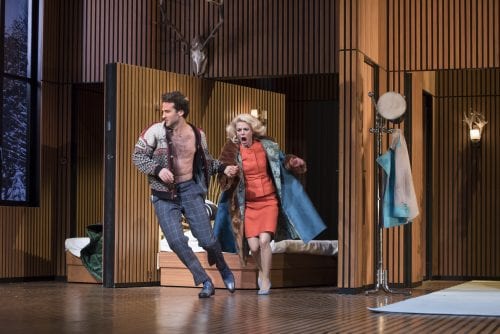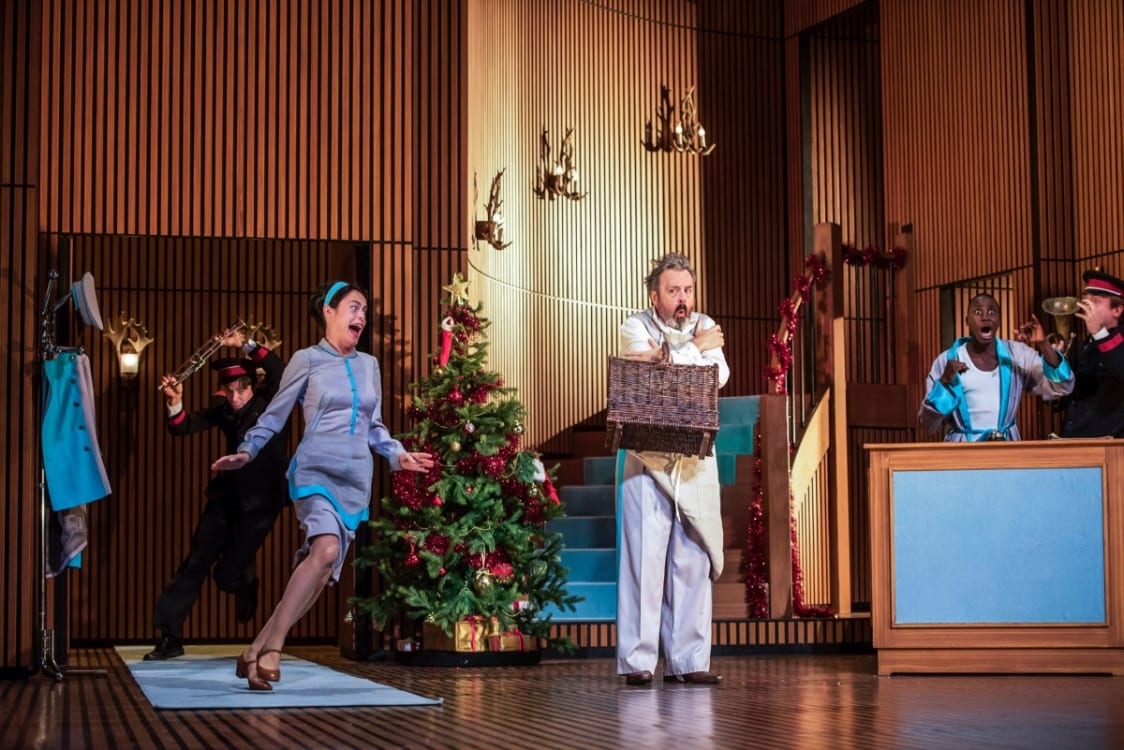Raymonde Chandebise suspects her husband, Victor-Emmanuel, is cheating on her. To be sure of it, she asks for help from her friend Lucienne Homénidès de Histangua. She convinces her to write an anonymous letter to her husband in which she confesses her love for him and asks him on a date at the charming hotel of the Minet-Galant. If Victor-Emmanuel goes to the appointment, it will then prove his infidelity. From one twist to another, the plot thickens, the situation becomes more and more absurd and comic and all the characters gradually turn mad… to our great pleasure.
Before the play begins, you contemplate the ingenious scenography realized by Andrew D Edwards. It represents a bourgeois interior, with a fake fireplace, a bearskin rug, a few pieces of colourful furniture and doors leading to the other rooms. Through a large frontal window, you can see the snow falling on a landscape of fir trees – but also sometimes some skiers or even a brass band!
Lilo Baur indeed transposed the action of the play (which originally took place in Paris at the turn of the 20th century) to the mountains, in the 1960s, during the Christmas season. For the director, it was a way to create a gap between the calm prevailing outside and the hysteria which rises, little by little penetrating all the characters inside.

The issues of the play then appear closer to us, and the final triumph of bourgeois values echoes as much with the years preceding the events of May 68 as they did at the turn of the 20th century. Thanks to this staging, Lilo Baur resorts to cultural references which cast a new light on this vaudeville. Indeed the actors’ work seems inspired by cartoons (like Tex Avery, especially during the transitions from one act to another when the actors entirely change the scenery), but also by silent movies (Jérémy Lopez then looks like Charlie Chaplin), action movies (mostly a beautiful scene played in slow motion in the hotel) and by clowning in general.
The actors put on great performances. I especially allude to Jean Chevalier, a victim of a speech impediment (he cannot pronounce consonants), and to Serge Bagdassarian passing – sometimes in a few seconds! – from the role of Victor-Emmanuel Chandebise to the one of Poche, the alcoholic houseboy. I finally note the performance of Pauline Clément and Anna Cervinka incarnating one of the funniest pair of best friends in French theatre.
More than a century after Feydeau wrote this beautiful text, the social satire is still alive. The characters of La Puce à l’oreille are ridiculous and mediocre, yet endearingly bourgeois, obsessed by appearances and mostly by their own sexuality – hidden behind their so-called moral values. In our time of still living in such bourgeois systems of representation despite decades of feminism and the relative questioning of heteronormativity, Lilo Baur’s staging makes strong sense.
Summary in French
Dans la mise en scène de Lilo Baur, les personnages de Feydeau se retrouvent à la montagne, dans les années 60. A l’esthétique du vaudeville s’ajoutent ici celles du film muet (et en particulier de Charlie Chaplin), du cartoon (on pense beaucoup à Tex Avery), du film d’action (confer une magnifique scène au ralenti!) et du clown en général. Cette satire sociale vue par Lilo Baur résonne étrangement aujourd’hui. A notre époque où le modèle bourgeois domine toujours malgré mai 68 et des décennies de féminisme, La Puce à l’oreille est plus que jamais d’actualité.

